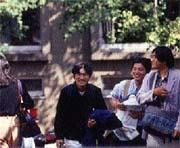
Lawrence University is in its second year of a three-year program with Waseda University that brings Japanese students to Lawrence. (Waseda University)
This year, there are 14 visiting students at Lawrence from Waseda University, one of Japan’s premier universities. They are here through a program between the two universities officially called Collaboration in Education and Study Abroad (CESA) and known to Lawrentians as the Waseda program.Waseda’s Center for International Education initiated the CESA program, which sends students from Waseda University to one of several small liberal arts colleges in the United States. Waseda University administrators wanted a greater number of their students to study abroad, and thus the CESA program was instituted.
Prior to the beginning of the CESA program, Lawrence already had a connection with Waseda through the Japan Study Program, a typical exchange program that works on a student-by-student basis.
Waseda students who come to Lawrence through the CESA program come specifically to study one of three concentrations: gender studies, environmental public policy, or international studies.
The Japanese students at Lawrence through the CESA program have a broader base of support than other visiting students, said Cecile Despres-Berry, instructor in English as a second language at Lawrence.
Waseda students are not required to have the same scores on the Test of English as a Foreign Language, and they have a more focused curriculum. In addition, Despres-Berry said, there are ESL classes and study groups for classes taken by many Waseda students.
The Waseda groups both last year and this year take Freshman Studies together. Last year, Dirck Vorenkamp, a teacher of East Asian religions, taught the first-ever section of Freshman Studies for Waseda students.
He spoke enthusiastically about the “wonderful learning opportunity for all of us,” saying he learned a great deal from the students he taught.
Vorenkamp said that he loves the “cultural exchange” that comes through the Waseda students’ presence on campus, saying, “The greatest [benefits] are those that are hardest to put your finger on or quantify.”
Most of the visiting students from Waseda are majors in fields like law, economics, commerce, or science. Despres-Berry pointed out that even though the Waseda students are taking most of their classes at Lawrence in one field, they are still experiencing the liberal arts because of the interdisciplinary nature of the areas of study and Freshman Studies.
One of Waseda’s goals is to create a college of liberal studies. Students at this school will be required to spend a year abroad. Through the CESA program, Waseda is establishing the connections that will enable it to find places for all those students.
The program was originally slated to last three years, but Despres-Berry said, “The goal from the beginning [has been] to extend it.” This is the second year that Lawrence has had visiting students from Waseda.
Before the CESA program, few students came to Lawrence from Japan, and few Lawrentians went to Japan to study. Lawrence has been increasing the focus on Japan in the past two years. This is the second year that Lawrence has offered a Japanese language program.
Despres-Berry feels that “interest in going to Japan is growing” among Lawrence students.
Yoko Sakamoto, a law student from Waseda who is studying international studies at Lawrence, said that she came to Lawrence both to work on her English and to study international studies. She had never visited the United States before her arrival at Lawrence in September.
Sakamoto noted many differences between Waseda and Lawrence; many of them are differences that one can find between Lawrence and a large American university as well. Sakamoto said that her classes at Waseda usually had about 200 students and that many students lived off-campus.
Although Despres-Berry admitted that there would be fewer differences between Waseda and an American state university, she feels that there is something of a “cultural difference between academic traditions” in Japan and the U.S.
She mentioned that even at a high school level, American classes tend to be more focused on discussion and student participation.
Despres-Berry said that the Waseda students seem to respect and be interested in the liberal arts style of education, but added that it is also more pressure for the students, especially since they are still learning English.
Sakamoto said, “Here we learn about how to think about things, but in Japan I only learn about knowledge.” She also added that she thinks Lawrence students have more homework and they study more.
Despres-Berry said that she thinks the challenges Waseda students face at Lawrence are the same ones the Lawrentians experience abroad. She mentioned language and culture shock.
Sakamoto had another insight: “It is very cold here… same as Japanese December.
